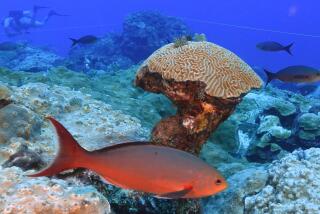Frigid Arctic Reef Provides Oasis for Marine Life : Marine biology: Alaska’s Boulder Patch supports hundreds of species of plants and animals.
- Share via
PRUDHOE BAY, Alaska — About 20 miles out on the frozen Arctic Ocean, Ken Dunton’s research trailer sits half-buried in a wasteland of ice and blowing snow.
But when Dunton dives through a hole cut in the trailer’s linoleum floor and through the seven feet of ice beneath it, he finds a jungle of life: a reef that supports several hundred species of plants and animals. The reef is known as the Boulder Patch.
“No one knows why it’s here,” the University of Texas marine biologist said. “In most of the Arctic Ocean, the ice just gouges the bottom away like a plow, all the time, and very little can grow. But this place has rocks, and they support all this life.”
To find another such diverse concentration of creatures, you would have to go halfway around the Arctic coast, well into Russia in one direction and Canada in the other, Dunton said.
The 12-square-mile reef northeast of Prudhoe Bay was found during federal seismic surveys in 1972. Since then, it has shown scientists that life goes on in conditions once thought too harsh.
“The plants are far more efficient at converting sunlight than we’d ever suspect,” Dunton said.
For nine months of the year, the Boulder Patch has almost no light and the water temperature is below 32 degrees Fahrenheit.
One kind of kelp there does 90% of its growing in the dark. During the brief summers it simply stores sunlight and then converts it in winter and spring, sending out new blades and growing up to 7 feet long.
“There’s not any kelp that can beat this one for minimum amount of light. We’re No. 1,” said Dunton.
The oasis also is home to bright coral, sponges, starfish, jellyfish, sea anemones, snails and a variety of tiny creatures such as sea spiders and sand fleas. Many are food for arctic cod and other fish, which also may exist in greater diversity here than in surrounding areas, Dunton said.
“When I came up here with Ken I couldn’t believe what I saw,” said diver Mike Dibble as he pulled on three layers of cold-weather gear before taking the plunge into the black, 29-degree water.
“You’d expect with this extreme environment you’d find a small group of highly specialized animals. I was amazed at the diversity, amazed at these very spectacular corals that you’d associate with tropical environments,” Dibble said.
“A lot of people into recreational diving would be astounded.”
Some scientists are. Bob Wilce, an arctic algae specialist at the University of Massachusetts, visited the Boulder Patch this spring. He said he has found a new genus there: a millimeter-high, bright green alga that hides in rock crevices. So far, he calls it just “Fuzzy.”
“Fuzzy’s a pretty important little plant,” said Wilce, who has found two other new genera in his 38-year career in the north.
On this visit to the Boulder Patch, he also found a brown crust that he identified under a microscope as a previously unseen stage of the reproductive life of another rare alga.
Russian scientists have done most of the work naming and describing arctic marine life, Dunton said, so he is working with them on categorizing the new finds.
The reef’s granite boulders probably were dragged in by glaciers from Canada and are partly protected from ice gouging by an island to the north. It is not clear why they were not covered long ago in sediment, however, since the Boulder Patch is near the mouth of a large river, the Sagavanirktok.
Dunton’s studies now are backed by a three-year, $200,000 National Science Foundation grant. He also gets funding and logistics help from BP Exploration, which operates the nearby Endicott oil field.
He and five assistants spent four weeks on the ice this spring collecting plant and animal samples in plastic bags. They drive out to their camp from Endicott in a Rolligon--a cab on monstrous rolling-pin wheels that barrel over ice ridges and snowdrifts.
Divers can stand only about 40 minutes in the frigid water. Then they are pulled back up, steaming, into the trailer, where the hum of a generator and a couple of computer printers drown out the howl of the wind.
Each morning, the 4-by-6-foot hole has to be cleared of the slush and ice that start to seal it off.
Dunton has been coming here for 15 years.
“Some of those guys down there are old friends,” he said. “I found five yesterday that I tagged in 1978.”
Still, the sea life has such a tenuous hold that if a rock is scraped, it takes a dozen years for it to be visibly recolonized, he said.
“It’s a very stressed environment.”
More to Read
Sign up for Essential California
The most important California stories and recommendations in your inbox every morning.
You may occasionally receive promotional content from the Los Angeles Times.













